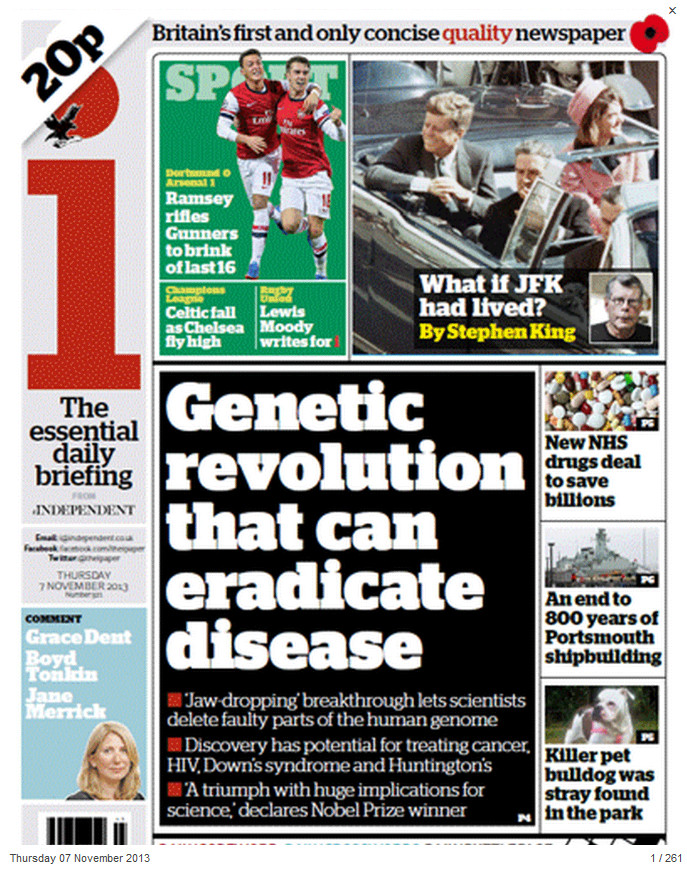The current front page of UK newspaper The Independent sports an article headlined ‘The Next Genetic Revolution’, exclusively detailing ‘Crispr’ – a novel technique for editing DNA. This technique, according to the article, could be the key step in developing cures for AIDS, cancer and inherited disorders. But do the facts back up the hype?

The Crispr technique is an enzyme-based method for editing nucleotides (the A, C, T and Gs of DNA) in a “phenomenally precise” manner. Highly esteemed scientists quoted in the article, such as Nobel Prize winner Craig Mellor, herald the bacteria-derived method as the most advanced technology available to correct DNA and provide solutions to the numerous diseases that have their origins in human genome.
You can find a truncated version of the story on the The Independent site as well as further background and a video animation.
Outside of the The Independent’s multi-page ‘exclusive’, however, reaction was more mixed. Our colleagues at the UK SMC collected the following expert commentary. Feel free to use these quotes in your reporting. If you would like to contact a New Zealand expert, please contact the SMC (04 499 5476; smc@sciencemediacentre.co.nz).
Professor Peter Braude Emeritus Professor of Obstetrics and Gynaecology, Division of Women’s Health , King’s College London, said:
“This is fascinating but I think a long way to go in relation to IVF. In the enthusiasm to envisage putative applications for this novel molecular technique to IVF in order to correct genetic disorders in the human embryo, sight is often lost of the fact that for almost all known genetic diseases there is always a proportion of embryos that do not contain the mutation and thus can be selected for by preimplantation genetic diagnosis, a relatively modest modification of the IVF technique without the need for genetic manipulation. As exciting as this new technique might be, why would anyone apply, or a patient accept a therapy that requires complex modification of the embryo’s DNA in the molecular biology laboratory in order to effect something that can already be achieved more simply and safely? Germ line therapy still has a long way to go before it is more widely accepted, both in terms of safety evaluation, and ethics of appropriateness of use.”
Professor George Church, Harvard, said:
“Talking about the future is better than letting it sneak up on us. We need to do more of this or we will be left with very limited vocabulary in the space between positive and negative hype.”
Professor Robin Lovell Badge, MRC National Institute for Medical Research, said:
“There is much deserved excitement in the basic science community about the CRISPR/Cas9 methods, which provide very efficient tools to understand gene function. Moreover, I can see why this excitement has spread to those keen to apply the techniques to cure genetic disease. But the hype needs to be tempered with a little caution. Although remarkably efficient compared to other techniques, the genetic changes introduced by the CRISPR technique are not always as perfect as designed and on occasion it could introduce problems that are just as worse as the one being corrected. Moreover, there are problems of “off-target” hits, where the method alters DNA at other (similar) sites elsewhere in the genome and not just the gene being targeted. We can deal with this in mice or fish by breeding the animals and segregating away the mutations at these other sites, but not with patients and these off-target mutations could be bad.
“Moreover, with respect to germline engineering with the aim of correcting defective genes in humans, I see little point when techniques such as PGD (pre-implantation genetic diagnosis) can be used to select embryos that do not have the defective gene – and we know this works well. What is not discussed in the Independent piece is the prospect of using the methods to change or “improve” rather than just correct gene defects. What about making people resistant to HIV ? It is far too early to contemplate doing this, and altering the germline in this way is illegal in the UK and many other countries. However, what is clear is that the new methods, deserve a proper consideration and debate, and not just hype or condemnation, so that the wonderful opportunities it presents can be applied sensibly. ”
Professor Dagan Wells, Oxford University, said:
“I think it’s important to stress that the therapeutic potential of this sort of genetic microsurgery is yet to be proven. Additionally, a significant amount of work will need to be done to assess the safety of the method before it can be used clinically. Still, the potential seems enormous.
“I guess the main attraction of applying this to embryos is that, since they are composed of just a handful of cells, it would be relatively easy to ensure that every cell was treated. Treating the trillions of cells that make up a baby would be much more challenging and it is likely that only a minority of cells would be successfully corrected.
“Of course, the problem with treating the embryo is that the future sperm and egg cells are also likely to be altered. In the past this has been a major concern because genes transferred during gene therapy are difficult to control, interacting with the genome in unpredictable ways and potentially doing more harm than good. The fear has been that accidental alterations affecting the germline could become an irreversible problem affecting countless future generations.
“If the new method is as precise as has been suggested then concerns about inducing inadvertent, detrimental changes to the genome might start to subside. In that case, permanently fixing a lethal genetic defect might not seem so controversial. However, I’m sure there will be some concern about the possibility that the technology could be used for ‘enhancement’ rather than repair, veering from medicine towards eugenics.”